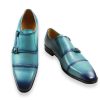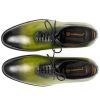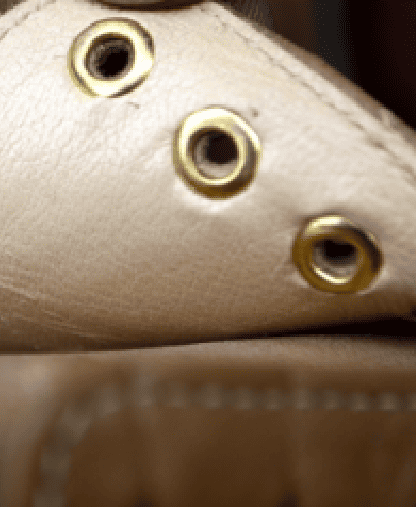Every masterpiece has its unsung hero—the detail that quietly ensures everything works seamlessly. For leather shoes, that hero is often the inner rings in eyelets. These tiny but crucial components play a big role in both durability and design, especially when paired with the timeless construction methods like hand welting and hand lasting.
Picture this: you’re lacing up your shoes. With every pull of the laces, tension builds at the eyelets. Over time, without proper reinforcement, this stress can stretch or tear the leather. This is where inner rings—those metal or plastic reinforcements hidden beneath the visible eyelets—step in. They absorb the strain, protecting the leather and ensuring your shoes stay as sturdy as they are stylish.
Why Inner Rings Are a Must-Have for Premium Leather Shoes
- Protection Against Wear and Tear
Leather, despite being strong, has its limits. Repeated pressure from laces can weaken the edges of the eyelets, causing fraying or even tearing. Inner rings distribute the tension evenly, acting as a shield for the leather. This is especially important in hand-lasted shoes, where precision and longevity are non-negotiable. - Structural Integrity for a Polished Look
Without inner rings, eyelets can sag or distort over time, affecting the shoe’s appearance. Rings keep the eyelets perfectly round, maintaining the clean, polished aesthetic that defines quality footwear. In high-end shoes, every detail matters—right down to the eyelets. - Enhanced Lacing Experience
Inner rings ensure smoother lacing. They create a rigid barrier between the leather and the lace, reducing friction and making it easier to tighten or adjust the laces. This feature isn’t just about convenience—it also prevents the laces from cutting into the leather, preserving both for the long haul.
The Benefits of Inner Rings for Comfort and Fit
Inner rings don’t just add durability; they can also improve the fit and comfort of leather shoes:
- Consistent Lace Tightening
- Eyelets with inner rings allow for smoother lacing. Because the rings provide a reinforced surface, laces slide more easily through the eyelets, enabling a more precise and consistent tightening. This allows the shoes to fit snugly and comfortably without the need to constantly readjust the laces.
- Protection from Abrasion
- Leather eyelets without reinforcement are more likely to rub against the laces, causing friction that can wear down both the laces and the leather itself. Inner rings act as a buffer, reducing abrasion and preventing unnecessary wear on the laces, which also means fewer broken laces over time.
- Improved Comfort for Extended Wear
- When eyelets are reinforced, the shoe holds its shape better, and the leather doesn’t stretch unevenly around the laces. This structural integrity ensures that the shoe conforms to the foot as intended, providing better support and comfort, especially for all-day wear.
The Craftsmanship Angle
At Handsole, incorporating inner rings into eyelets is a deliberate choice. For hand welted shoes, where durability and craftsmanship are paramount, these reinforcements are non-negotiable. They complement the robust construction by protecting one of the most vulnerable parts of the shoe—the lace holes.
Technical Talk: Choosing the Right Material for Inner Rings
Inner rings come in various materials, from stainless steel to brass to high-grade plastics. Each material offers different benefits:
- Metal Rings (Steel or Brass): Ideal for rugged shoes, providing unmatched durability. They’re resistant to deformation, even under intense pressure.
- Plastic Rings: Lightweight and corrosion-resistant, suitable for shoes exposed to moisture or for those seeking a minimalist touch.
The choice of material depends on the shoe’s intended use and design. At Handsole, we prioritize materials that align with the shoe’s character and the needs of its wearer.
Inner Rings: A Small Detail with Big Impact
In the art of shoemaking, it’s often the unseen elements that set a pair apart. Inner rings in eyelets might be hidden, but their impact on the shoe’s strength, comfort, and aesthetics is undeniable. Whether you’re tightening your laces for a long day at work or dressing up for a special occasion, these tiny reinforcements work quietly to ensure your shoes hold up, wear beautifully, and stay dependable.
At Handsole, every detail matters. From the leather we hand-skive to the inner rings in our eyelets, we craft shoes designed to stand the test of time. Because when it comes to quality, no detail is too small.
Why Many Manufacturers Skip Inner Rings
Adding inner rings to eyelets requires additional materials, time, and skilled labor. For mass-market manufacturers, this detail might seem unnecessary or too costly for their production model. As a result, many shoes on the market lack this reinforcement, opting for simpler, single-layer eyelets to cut costs.
Reasons some manufacturers skip inner rings:
- Cost Savings: Inner rings require extra metal and more time to install, which increases production costs. For manufacturers focused on minimizing expenses, skipping this step allows for cheaper production, but at the cost of durability.
- Time Efficiency: Adding inner rings is a meticulous process that takes longer than standard eyelet installation. For high-output manufacturers, this can slow down production lines.
- Less Emphasis on Longevity: Shoes designed for short-term use or fashion trends may not prioritize durability, so manufacturers might skip reinforcements that make a shoe last longer.
While skipping inner rings can reduce costs, it also compromises the shoe’s resilience and strength, especially in demanding situations.
How to Tell If Your Shoes Have Inner Rings
Wondering if your leather shoes have this added level of craftsmanship? Here’s how to check:
- Look Inside the Eyelet Hole: Take a close look inside each eyelet. If there’s a visible metal ring on the inside of the shoe, then the eyelet has inner reinforcement.
- Feel for the Metal Reinforcement: If you can’t see inside the eyelet, gently run your finger around it from the inside of the shoe. The metal ring should feel firm and smooth, providing a distinct difference from the plain leather.
- Inspect the Leather for Stretching: Shoes without inner rings often show signs of stretching, fraying, or wear around the eyelets after only a short period of use. If your shoes show little to no wear around the eyelets despite frequent use, they likely have inner ring reinforcements.
The Difference Inner Rings Make in Premium Shoe Crafting
Inner rings are often a hallmark of high-quality, well-crafted shoes. In premium and handmade footwear, every part of the shoe is carefully considered to enhance both functionality and aesthetics. Inner rings represent the shoemaker’s commitment to durability and comfort, providing a small but powerful detail that can significantly improve the shoe’s performance over time.
Benefits in premium shoes include:
- Extended Lifespan: Inner rings help preserve the structural integrity of the shoe, meaning your shoes will stay in good shape longer and require fewer repairs.
- Better Fit and Functionality: With reinforced eyelets, laces hold their position better, making it easier to achieve a secure fit that stays in place throughout the day.
- Attention to Detail: Inner rings signify quality craftsmanship. When manufacturers add this feature, it shows a commitment to creating shoes that not only look good but are also built to last.
Conclusion
When investing in leather shoes, the details matter. Inner rings in eyelets may seem like a small, hidden feature, but they play a crucial role in the durability, comfort, and overall quality of the footwear. Shoes with inner rings are built to withstand the everyday strain of lacing and unlacing, providing longer-lasting, more comfortable wear.
Next time you’re shopping for leather shoes, take a closer look at the eyelets. If you see inner rings, you’re looking at a pair crafted with attention to detail and built to stand the test of time. Investing in shoes with inner-ring eyelets means choosing durability, comfort, and the refined quality of true craftsmanship.













